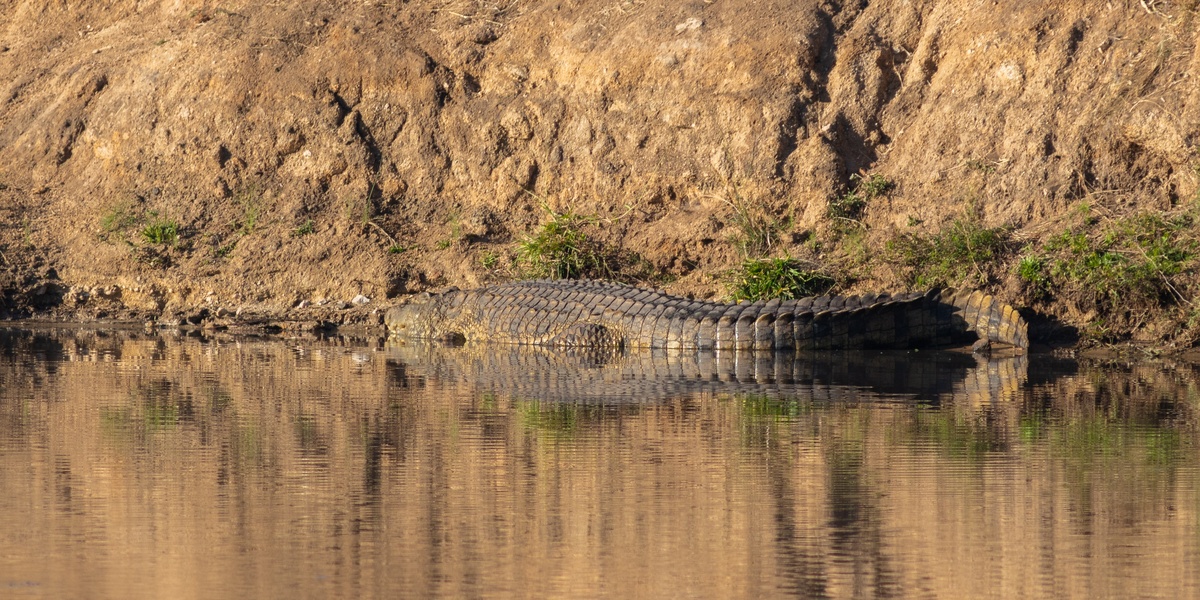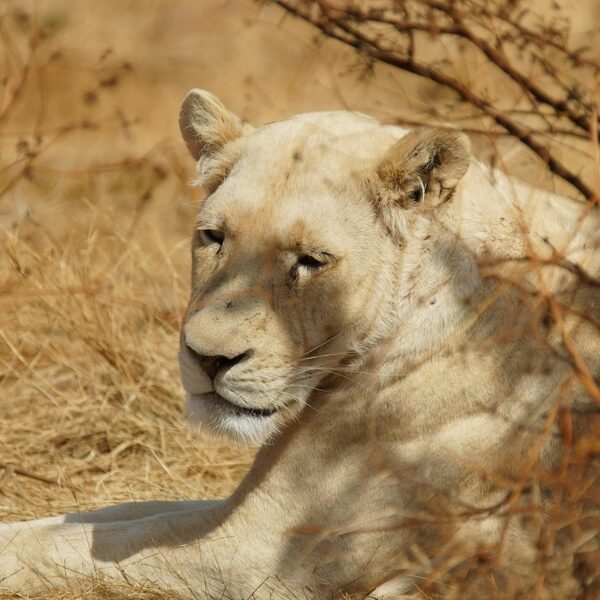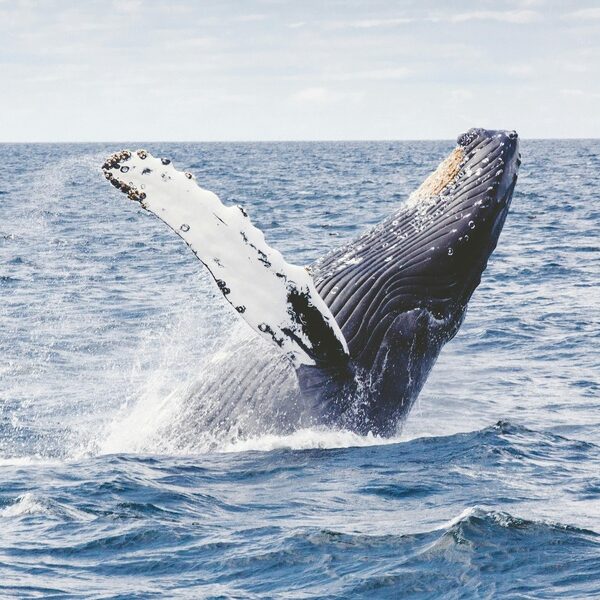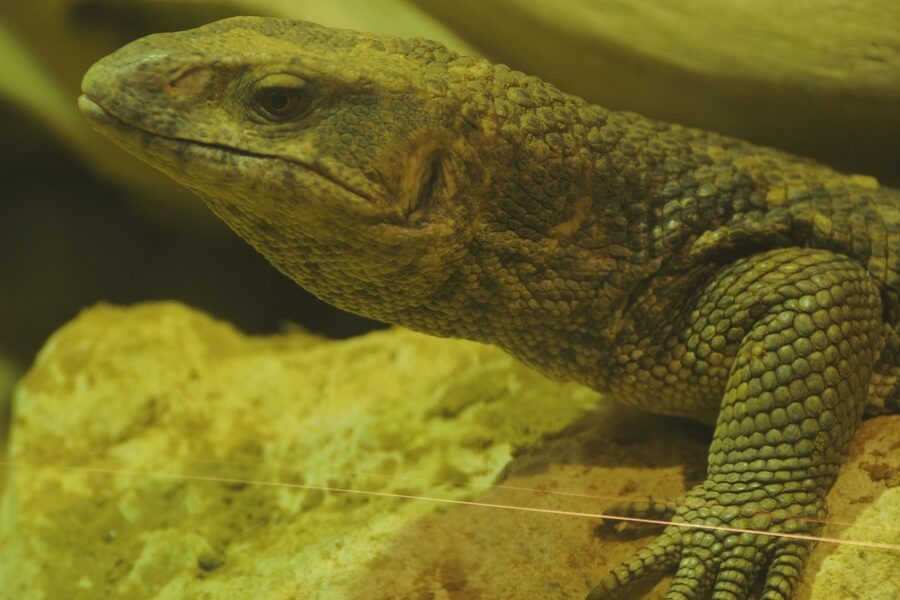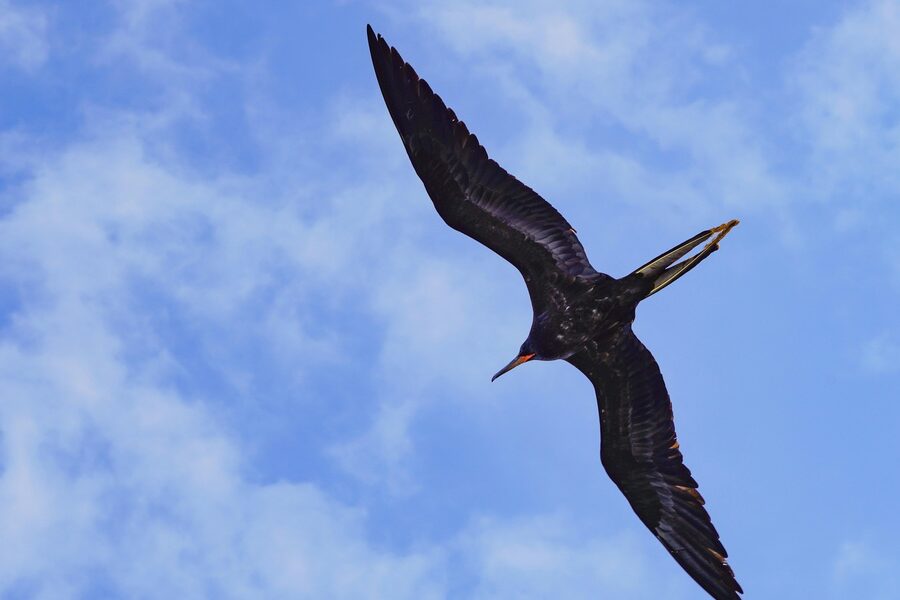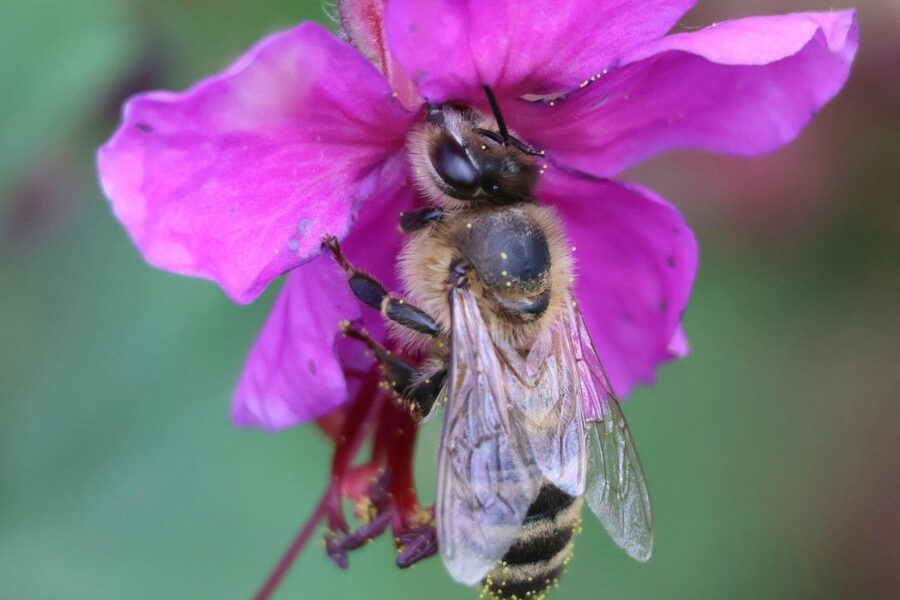Zimbabwe’s rivers, savannas and rocky outcrops support a broad suite of reptiles adapted to different microhabitats, from aquatic turtles and crocodiles to terrestrial lizards and snakes. Observing seasonal movements and habitat preferences is key to understanding how species use Zimbabwe’s varied landscapes.
There are 92 Reptiles of Zimbabwe, ranging from African Helmeted Terrapin to Zambezi Softshell Turtle. The list is organized with Scientific name, Typical adult size (cm), Range & habitat so you can quickly compare identity, size and where each species is found — you’ll find these details below.
Does the count of 92 include introduced or accidental species?
Most published lists aim to include species reliably recorded within Zimbabwe, covering native and regularly occurring residents; introduced, accidental or questionable records may be noted separately or excluded, so check each entry’s Range & habitat for status and occurrence notes.
Which reptiles should visitors be most careful around and where are they found?
Primary risks come from large crocodiles near rivers and lakes and several venomous snakes (e.g., puff adders, certain cobras) found in grassland, woodland edges and near water; use caution at night and near water, and consult the Range & habitat details below for hotspot guidance.
Reptiles of Zimbabwe
| Name | Scientific name | Typical adult size (cm) | Range & habitat |
|---|---|---|---|
| Nile Crocodile | Crocodylus niloticus | 400 | Widespread in major rivers, dams, and lakes; aquatic habitats. |
| Leopard Tortoise | Stigmochelys pardalis | 40 | Widespread across Zimbabwe in savanna, grassland, and thornveld. |
| Bell’s Hinge-back Tortoise | Kinixys belliana | 18 | Widespread in moist savanna and woodland, especially in the north and east. |
| Speke’s Hinge-back Tortoise | Kinixys spekii | 16 | Widespread in dry savanna and rocky areas, often near kopjes. |
| African Helmeted Terrapin | Pelomedusa subrufa | 20 | Widespread and common in almost any freshwater body, including temporary pans. |
| Serrated Hinged Terrapin | Pelusios sinuatus | 35 | Northern Zimbabwe; large rivers like the Zambezi, Limpopo, and Sabi. |
| Okavango Hinged Terrapin | Pelusios bechuanicus | 30 | North-western Zimbabwe in the upper Zambezi system; clear, permanent water. |
| Mashona Hinged Terrapin | Pelusios rhodesianus | 22 | Northern and eastern highlands; well-vegetated pans, streams, and marshes. |
| Zambezi Softshell Turtle | Trionyx triunguis | 70 | Zambezi River system in northern Zimbabwe. |
| Southern Tree Agama | Acanthocercus atricollis | 35 | Eastern and northern Zimbabwe; savanna woodland and suburban gardens. |
| Kirk’s Rock Agama | Agama kirkii | 28 | Widespread on rocky outcrops (kopjes) and granite hills. |
| Ground Agama | Agama aculeata | 25 | Widespread in arid savanna, Kalahari sandveld, and scrubland. |
| Flap-necked Chameleon | Chamaeleo dilepis | 30 | Widespread in moist savanna, woodland, and suburban gardens. |
| Marshall’s Leaf Chameleon | Rhampholeon marshalli | 7 | Endemic to the moist forests of the Bvumba Mountains, eastern highlands. |
| Common Tropical House Gecko | Hemidactylus mabouia | 12 | Widespread, common on and in buildings, also on rock faces. |
| Wahlberg’s Velvet Gecko | Homopholis wahlbergii | 18 | South and west; savanna woodland, under bark, or in hollow trees. |
| Bibron’s Thick-toed Gecko | Pachydactylus bibronii | 16 | Widespread in savanna and rocky areas, often on buildings. |
| Turner’s Gecko | Chondrodactylus turneri | 15 | North and west Zimbabwe; arid savanna and rocky areas. |
| Cape Thick-toed Gecko | Pachydactylus capensis | 10 | Widespread across the central plateau; under rocks and logs in savanna. |
| Yellow-headed Dwarf Gecko | Lygodactylus picturatus | 8 | Northern Zimbabwe, especially Zambezi valley; savanna and woodland trees. |
| Cape Dwarf Gecko | Lygodactylus capensis | 7 | Widespread in savanna and woodland, on trees and fences. |
| Giant Plated Lizard | Gerrhosaurus validus | 60 | Widespread in rocky areas, associated with granite kopjes. |
| Yellow-throated Plated Lizard | Gerrhosaurus flavigularis | 40 | Widespread in grassland and open savanna, avoiding rocky areas. |
| Black-lined Plated Lizard | Gerrhosaurus nigrolineatus | 40 | North and west Zimbabwe; moist savanna and woodland. |
| Tawny Plated Lizard | Gerrhosaurus major | 45 | Lowveld regions of the south-east; dry savanna and riverine woodland. |
| Common Flat Lizard | Platysaurus intermedius | 25 | Widespread on granite and sandstone outcrops (kopjes). |
| Emperor Flat Lizard | Platysaurus imperator | 30 | Endemic to the granite hills of the Mutare and Mutorashanga areas. |
| Dwarf Flat Lizard | Platysaurus guttatus | 15 | Eastern highlands and adjacent areas on granite outcrops. |
| Limpopo Girdled Lizard | Cordylus jonesii | 15 | Southern Zimbabwe, Limpopo valley; savanna woodland on trees. |
| Common Girdled Lizard | Cordylus cordylus | 20 | Eastern highlands of Zimbabwe; rocky slopes and montane grassland. |
| Rock Monitor | Varanus albigularis | 150 | Widespread in savanna, woodland, and rocky areas. |
| Nile Monitor | Varanus niloticus | 200 | Widespread near water; rivers, dams, lakes, and marshes. |
| Common Variable Skink | Trachylepis varia | 12 | Widespread and very common in savanna, grassland, and gardens. |
| Rainbow Skink | Trachylepis margaritifer | 20 | Eastern and northern Zimbabwe; rocky outcrops and savanna. |
| Five-lined Skink | Trachylepis quinquetaeniata | 20 | North and west; savanna and rocky areas. |
| Kalahari Tree Skink | Trachylepis spilogaster | 15 | Western Zimbabwe in Kalahari sands; arboreal in savanna woodland. |
| Speckle-lipped Skink | Trachylepis punctatissima | 10 | Eastern highlands; montane grasslands and forest edges. |
| Sundevall’s Writhing Skink | Mochlus sundevallii | 15 | Widespread in savanna with sandy soils. |
| Striped Skink | Trachylepis striata | 18 | Widespread and common in savanna, woodland, and suburbia. |
| Jalla’s Sand Lizard | Heliobolus lugubris | 20 | Western Zimbabwe, Kalahari sands; arid savanna. |
| Common Sand Lizard | Nucras tessellata | 25 | Western Zimbabwe, Kalahari sands; open, sandy habitats. |
| Ornate Sandveld Lizard | Nucras ornata | 20 | Central and eastern Zimbabwe highveld; grassland and open savanna. |
| Holub’s Sandveld Lizard | Nucras holubi | 18 | Northern Zimbabwe; savanna and woodland. |
| Southern Rock-dwelling Sand Lizard | Pedioplanis ‘namaquensis’ complex | 15 | Southeastern lowveld on rocky substrates. |
| Burchell’s Sand Lizard | Pedioplanis burchelli | 14 | Western Zimbabwe on Kalahari sand. |
| Wahlberg’s Snake-eyed Skink | Panaspis wahlbergii | 10 | Eastern Zimbabwe; savanna, grassland, and forest edges. |
| Cunene Snake-eyed Skink | Panaspis kennedyi | 9 | North-western Zimbabwe; sandy soils in dry savanna. |
| Spotted-neck Snake-eyed Lizard | Pedioplanis lineoocellata | 16 | Southern and western Zimbabwe; arid savanna and scrubland. |
| Spotted Bush Snake | Philothamnus semivariegatus | 90 | Widespread in savanna and woodland, especially near water. |
| Green Water Snake | Philothamnus hoplogaster | 60 | Eastern and northern Zimbabwe; damp savanna, marshes, and near streams. |
| Angolan Green Snake | Philothamnus angolensis | 100 | Northern Zimbabwe; moist savanna and forest. |
| Southern Brown Egg-eater | Dasypeltis inornata | 75 | Eastern highlands of Zimbabwe. |
| Common Egg-eater | Dasypeltis scabra | 70 | Widespread throughout Zimbabwe in various habitats. |
| Herald Snake | Crotaphopeltis hotamboeia | 60 | Widespread, especially in damp areas and suburban gardens. |
| Tiger Snake | Telescopus semiannulatus | 70 | Widespread in savanna and rocky areas. |
| Boomslang | Dispholidus typus | 150 | Widespread in savanna and woodland; highly arboreal. |
| Twig Snake | Thelotornis capensis | 120 | Widespread in savanna and woodland. |
| Mole Snake | Pseudaspis cana | 120 | Widespread on the central plateau; savanna and grassland. |
| Olive Snake | Lycodonomorphus inornatus | 80 | Eastern highlands; near streams, marshes, and damp places. |
| Common Wolf Snake | Lycophidion capense | 40 | Widespread in savanna and grassland, often under rocks or logs. |
| Variegated Wolf Snake | Lycophidion variegatum | 35 | Northern and eastern Zimbabwe; moist savanna. |
| Common File Snake | Mehelya capensis | 120 | Widespread in savanna and woodland. |
| Black File Snake | Mehelya nyassae | 70 | Northern and eastern lowveld; moist savanna. |
| Purple-glossed Snake | Amblyodipsas polylepis | 40 | Northern and eastern Zimbabwe; savanna. |
| Kalahari Purple-glossed Snake | Amblyodipsas ventrimaculata | 35 | Western Zimbabwe in Kalahari sands. |
| Bibron’s Stiletto Snake | Atractaspis bibronii | 50 | Widespread in most habitats, especially sandy soils. |
| Quill-snouted Snake | Xenocalamus mechowii | 50 | Western Zimbabwe in Kalahari sands. |
| Elongate Shovel-snout | Prosymna jani | 25 | South-eastern lowveld; sandy soils in arid savanna. |
| Sundevall’s Shovel-snout | Prosymna sundevallii | 30 | Widespread in savanna with sandy or alluvial soils. |
| Dwarf Sand Snake | Psammophis angolensis | 40 | Widespread in open savanna and grassland. |
| Short-snouted Grass Snake | Psammophis brevirostris | 80 | Widespread on the central plateau; savanna and grassland. |
| Stripe-bellied Sand Snake | Psammophis subtaeniatus | 100 | Widespread in dry savanna and scrubland. |
| Olive Grass Snake | Psammophis mossambicus | 120 | Northern and eastern lowveld; moist savanna, often near water. |
| Jalla’s Sand Snake | Psammophis jallae | 70 | Western Zimbabwe, Kalahari sandveld. |
| Lined Shovel-snout | Prosymna lineata | 25 | Northern Zimbabwe; savanna. |
| Slender Thread Snake | Leptotyphlops scutifrons | 20 | Widespread in most habitats, usually found under rocks or logs. |
| Peters’ Thread Snake | Leptotyphlops conjunctus | 15 | Eastern Zimbabwe; montane and forest habitats. |
| Beaked Blind Snake | Rhinotyphlops schinzi | 25 | Western Zimbabwe, Kalahari sands; arid, sandy regions. |
| Zambezi Garter Snake | Elapsoidea sundevallii longicauda | 50 | Northern Zimbabwe, along the Zambezi valley. |
| Anchieta’s Cobra | Naja anchietae | 150 | North-western Zimbabwe; arid savanna and Kalahari sandveld. |
| Snouted Cobra | Naja annulifera | 180 | Widespread in savanna and woodland. |
| Mozambique Spitting Cobra | Naja mossambica | 120 | Widespread in savanna, especially near water. |
| Forest Cobra | Naja melanoleuca | 220 | Eastern highlands forests. |
| Rinkhals | Hemachatus haemachatus | 110 | Highveld of eastern Zimbabwe. |
| Black Mamba | Dendroaspis polylepis | 250 | Widespread in savanna, woodland, and rocky outcrops, avoiding desert. |
| Green Mamba | Dendroaspis angusticeps | 180 | Forests of the eastern highlands. |
| Southern African Python | Python natalensis | 400 | Widespread, often near water and rocky outcrops. |
| Rhombic Night Adder | Causus rhombeatus | 60 | Widespread in most habitats, often near damp areas. |
| Snouted Night Adder | Causus defilippii | 30 | Widespread in moist savanna. |
| Puff Adder | Bitis arietans | 100 | Widespread and common in all habitats. |
| Gaboon Viper | Bitis gabonica | 150 | Eastern highlands forests. |
| Berg Adder | Bitis atropos | 40 | Montane grasslands of the eastern highlands. |
Images and Descriptions
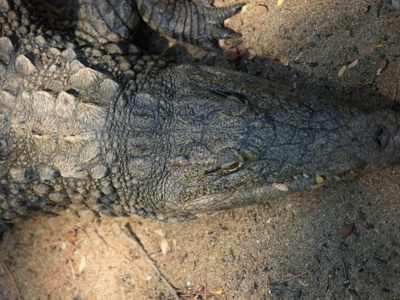
Nile Crocodile
Africa’s largest reptile and an apex predator with a powerful bite. It plays a crucial role in aquatic ecosystems. While widespread, populations face threats from habitat loss and human-wildlife conflict. Caution is advised near water bodies.
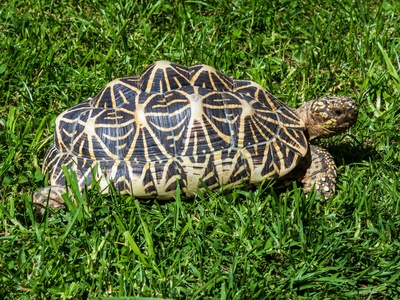
Leopard Tortoise
A large, strikingly patterned tortoise with a high-domed shell marked with black blotches. It is a grazer, feeding on grasses and succulents. This species does not hibernate and is a popular (but protected) reptile.
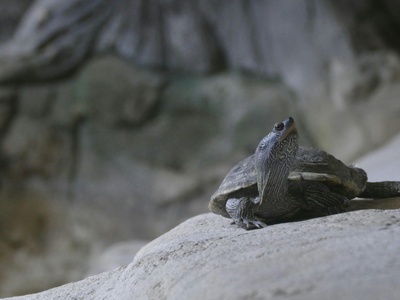
Bell’s Hinge-back Tortoise
This tortoise has a unique hinge on the back of its shell, allowing it to close down over its hind legs for protection. It’s an omnivore, feeding on fungi, fruits, and invertebrates.
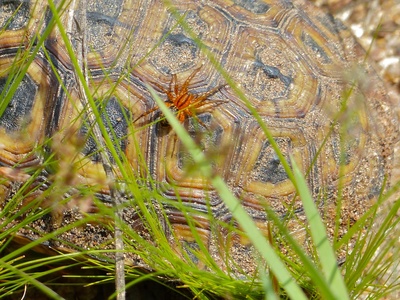
Speke’s Hinge-back Tortoise
Smaller and flatter than Bell’s, this tortoise is adapted to drier habitats. It is most active during the rainy season and aestivates during dry periods, often using rock crevices or animal burrows to shelter.
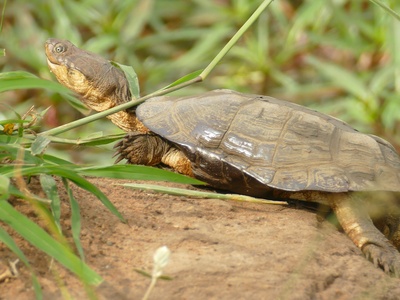
African Helmeted Terrapin
A highly adaptable aquatic turtle known for the foul-smelling musk it secretes when threatened. It is an opportunistic carnivore, preying on insects, fish, and frogs, and will also scavenge. It can survive long droughts by burying itself in mud.
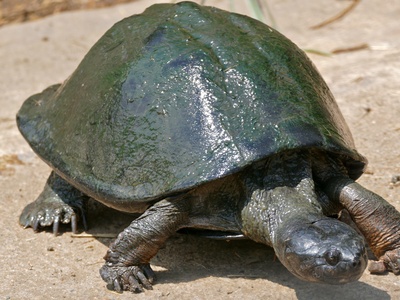
Serrated Hinged Terrapin
A large freshwater terrapin with a distinctly serrated rear edge on its shell. It is a strong swimmer found in permanent, deep water bodies, where it basks on logs and rocks. Its diet consists of aquatic snails, fish, and plants.
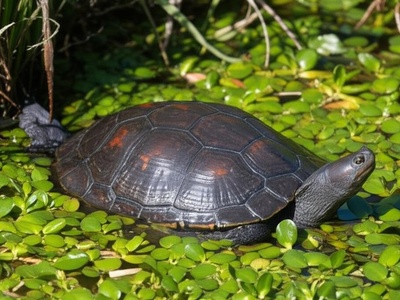
Okavango Hinged Terrapin
A dark-shelled, semi-aquatic turtle with a more restricted range in Zimbabwe. It prefers deep, clear swamps and rivers with abundant vegetation. It is shy and quick to dive for cover if disturbed.
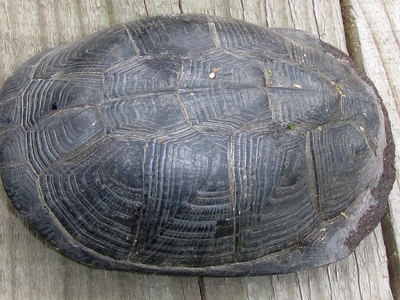
Mashona Hinged Terrapin
A medium-sized terrapin found in the well-watered regions of the Mashonaland plateau. It has a smooth, dark carapace and is often found in wetlands with dense aquatic plant life, where it forages for invertebrates.
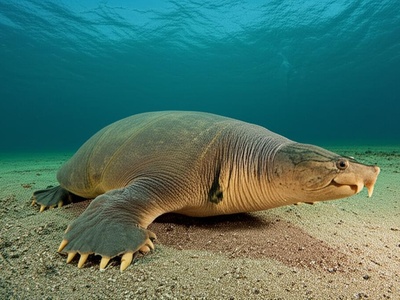
Zambezi Softshell Turtle
A very large, flat, aquatic turtle with a leathery shell instead of hard scutes. It is a powerful swimmer with webbed feet and a snorkel-like snout, allowing it to breathe while submerged. It is rarely seen, spending most of its time in the water.
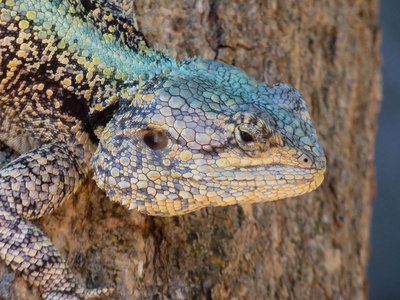
Southern Tree Agama
A large, robust lizard often seen basking on tree trunks or fence posts. Breeding males are spectacular, with a vibrant blue-green head and a grey-brown body. They are territorial and communicate with head-bobbing displays.
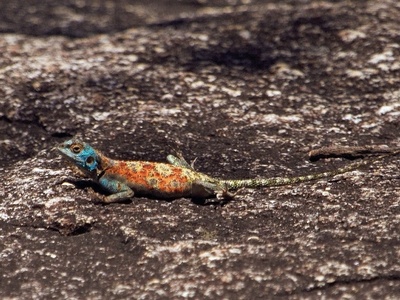
Kirk’s Rock Agama
A flattened body allows this agile lizard to retreat into narrow rock crevices to escape predators. Breeding males are very colourful, with a bright blue or purple head and a yellow-orange body. They live in colonies ruled by a dominant male.
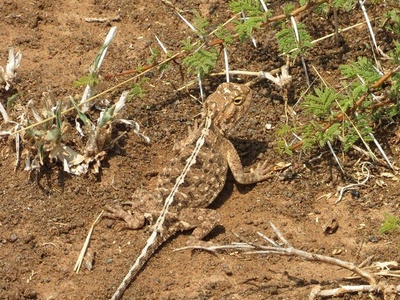
Ground Agama
A terrestrial lizard with spiny scales, providing excellent camouflage on sandy soils. It is a fast runner that often digs shallow burrows at the base of bushes to escape the heat and predators.
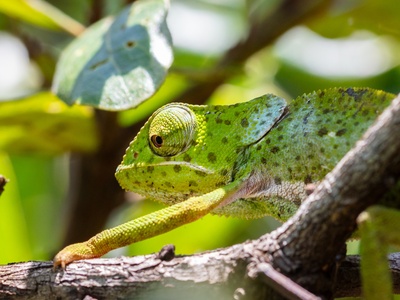
Flap-necked Chameleon
A common, large chameleon recognized by the fleshy lobes or ‘flaps’ on its head. It is an expert at camouflage, changing color for communication and concealment. Though slow-moving, it has a surprisingly fast-extending tongue.
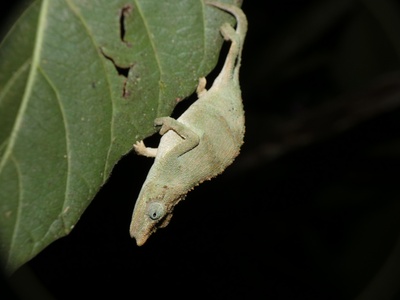
Marshall’s Leaf Chameleon
One of Africa’s smallest chameleons, this tiny reptile perfectly mimics a dead leaf. It lives in leaf litter on the forest floor and is a master of camouflage. This species is threatened by habitat loss due to deforestation.
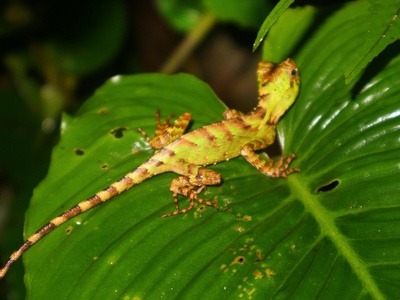
Common Tropical House Gecko
Often seen at night near lights hunting insects. This small, pale gecko is a familiar sight in homes across Zimbabwe. It is harmless and beneficial, controlling pests like mosquitoes. Its sticky toe pads allow it to climb vertical surfaces effortlessly.
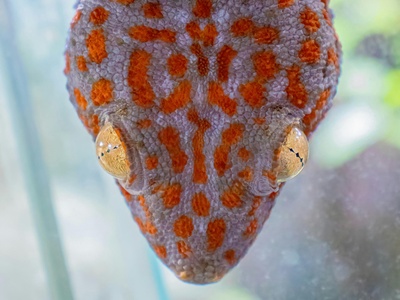
Wahlberg’s Velvet Gecko
A large, nocturnal gecko with a soft, velvety skin and a robust body. It is often found in trees, especially acacia and mopane. Despite its gentle appearance, it can inflict a painful (but harmless) bite if handled.
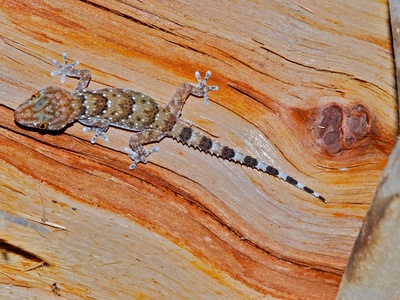
Bibron’s Thick-toed Gecko
A large, robust, and fast-moving gecko covered in tubercular scales, giving it a rough texture. It’s a common sight on walls and rock faces at night. This gecko is bold and will bite readily if it feels threatened.
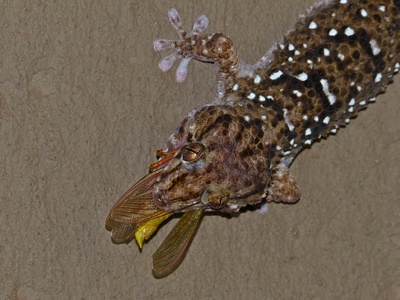
Turner’s Gecko
A large, ground-dwelling gecko with a mottled pattern that blends in with sandy or rocky terrain. It has large eyes for nocturnal vision and is often seen on the ground or low on rocks at night while hunting insects.
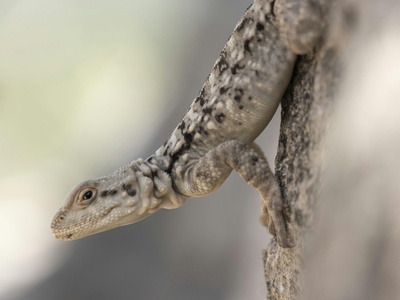
Cape Thick-toed Gecko
A small, common, ground-dwelling gecko found throughout the highveld. It has a variable pattern of dark blotches on a lighter background. During the day, it shelters under stones, loose bark, or in termite mounds.
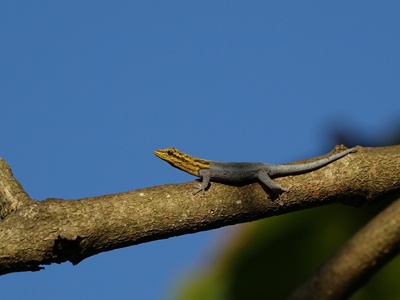
Yellow-headed Dwarf Gecko
A small, diurnal gecko often seen on tree trunks and buildings. Males are unmistakable, with a brilliant yellow head, blue body, and black throat markings. Females are more drably coloured. They are active hunters of ants and other small insects.
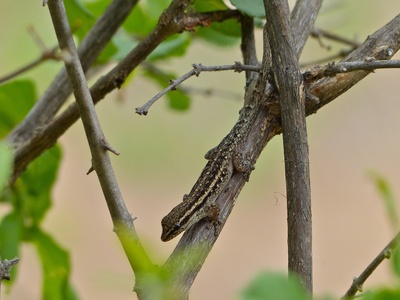
Cape Dwarf Gecko
A tiny, cryptically coloured gecko that is extremely common but often overlooked. It has a distinctive dark stripe running through the eye. It is diurnal and can be seen scampering up tree trunks in search of tiny insect prey.
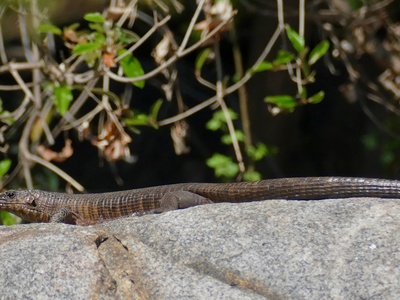
Giant Plated Lizard
Zimbabwe’s largest lizard, this impressive reptile is heavily armoured with plate-like scales. It lives in colonies in rock crevices, often basking near its retreat. It is omnivorous, eating insects, small vertebrates, and plant matter like flowers.
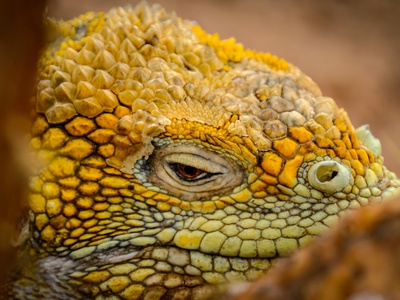
Yellow-throated Plated Lizard
A slender, fast-moving lizard named for the bright yellow (sometimes red or orange) throat of breeding males. It lives in burrows and is often seen foraging in open, grassy habitats during the day.
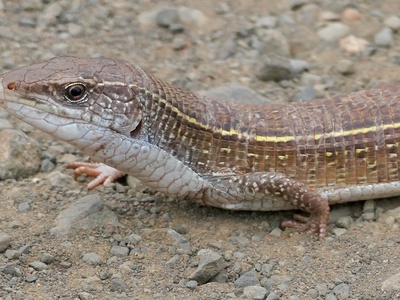
Black-lined Plated Lizard
Similar to the Yellow-throated Plated Lizard, but distinguished by a prominent black line running along its side. It prefers moister savanna habitats and is an active forager, feeding on a wide variety of insects.
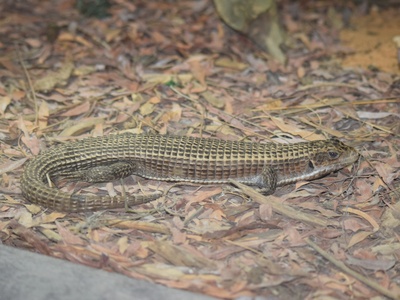
Tawny Plated Lizard
A large, heavily-built plated lizard with a robust head and rough scales. It is more sluggish than its relatives and often digs its own burrows in sandy soil. Its tail is particularly thick at the base.
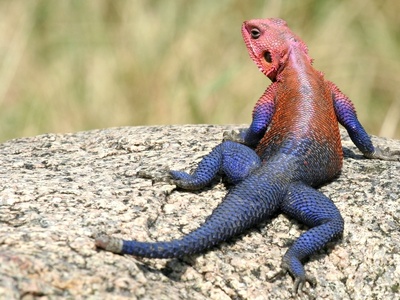
Common Flat Lizard
A spectacularly coloured lizard, with males displaying a rainbow of green, blue, and orange. Females and juveniles are striped black and white. Their extremely flattened bodies are an adaptation for hiding in the thinnest of rock cracks.
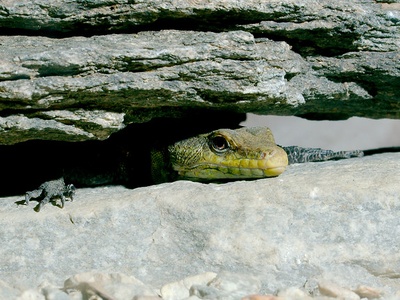
Emperor Flat Lizard
A large and stunningly beautiful flat lizard. The male’s head is bright orange-red, the forebody is yellow-green, and the rear is deep blue. This species is highly sought after in the illegal pet trade, posing a significant conservation threat.
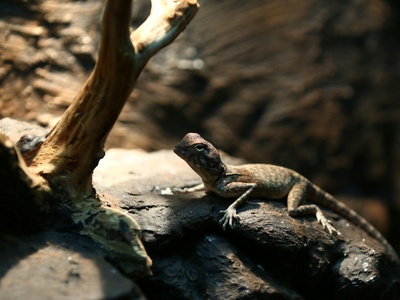
Dwarf Flat Lizard
A smaller species of flat lizard. Males have a greenish head and body with pale spots, and a reddish-brown tail. They share their rock-crevice habitat with larger flat lizard species, scorpions, and other creatures.
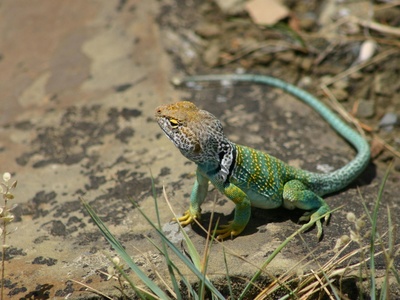
Limpopo Girdled Lizard
A small, arboreal girdled lizard that lives under the loose bark of dead trees, particularly acacia and mopane. It has a spiny tail and a flattened body, perfect for its crevice-dwelling lifestyle. They are often found in small groups.
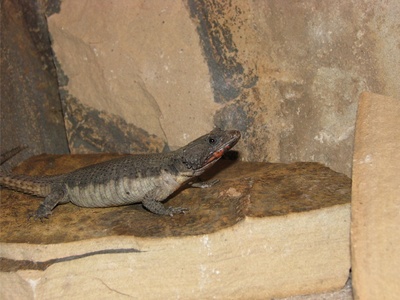
Common Girdled Lizard
A medium-sized, spiny lizard that lives in rock crevices. When threatened, it will wedge itself into a crack and inflate its body, making extraction very difficult. It is typically dark brown or black and basks near its retreat.
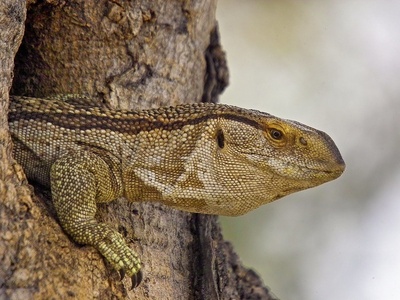
Rock Monitor
A very large, powerful lizard, second in size only to the Nile Monitor in Zimbabwe. It is a terrestrial forager with strong claws for digging and climbing. It has a varied diet, including insects, reptiles, birds, and carrion.
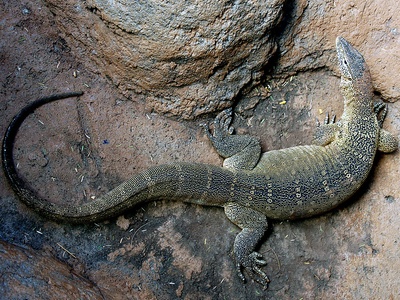
Nile Monitor
A huge, semi-aquatic lizard and a formidable predator. It is an excellent swimmer and climber, often raiding crocodile nests for eggs. Its powerful tail can be used as a whip for defense, and it can deliver a serious bite.
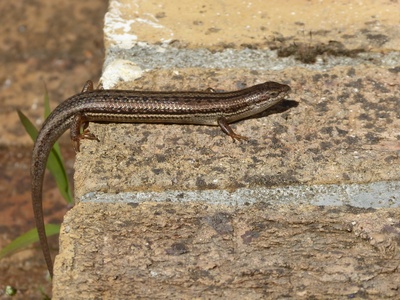
Common Variable Skink
A small, adaptable skink that is one of the most frequently seen reptiles. Its colour and pattern are highly variable, but it often has a striped or spotted appearance. It is an active, sun-loving lizard that hunts small insects.
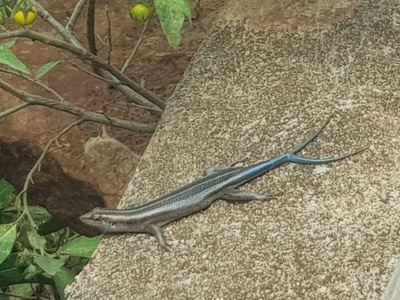
Rainbow Skink
A colourful, medium-sized skink, especially during the breeding season when males develop a bright orange head and a blue tail. It is fast and agile, typically found on granite kopjes, where it basks and hunts for insects.
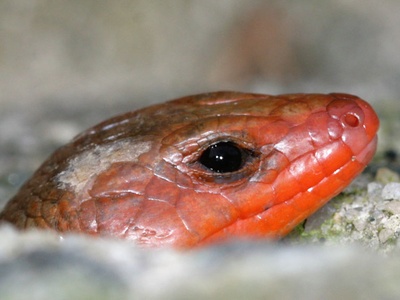
Five-lined Skink
A beautiful skink easily identified by the five bright stripes running down the back of juveniles and females. In breeding males, the stripes fade and they develop a vibrant orange-red head and throat.
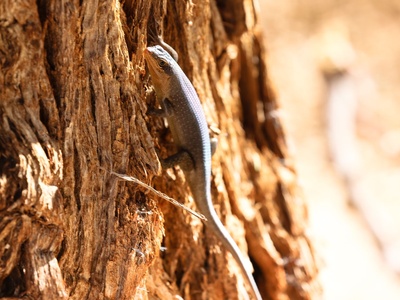
Kalahari Tree Skink
This skink is adapted to a life in trees. It has a slender body and a prehensile tail, allowing it to move with agility through branches. It is often found under loose bark on acacia trees.
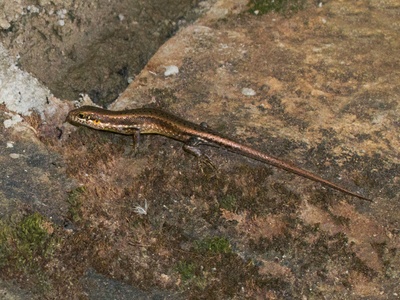
Speckle-lipped Skink
A small, ground-dwelling skink found at higher altitudes. It is named for the small white speckles on its lips and is often seen basking on rocks or logs in sunny patches within its cool, moist habitat.
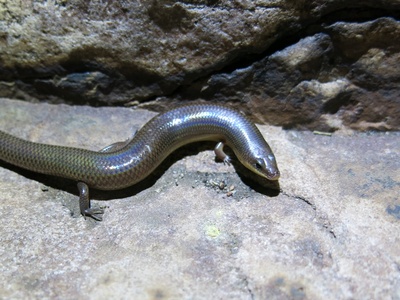
Sundevall’s Writhing Skink
A burrowing skink with a cylindrical body, smooth scales, and small legs. It ‘swims’ through loose soil and leaf litter, earning its name. It is secretive and most often found when digging or turning over logs and rocks.
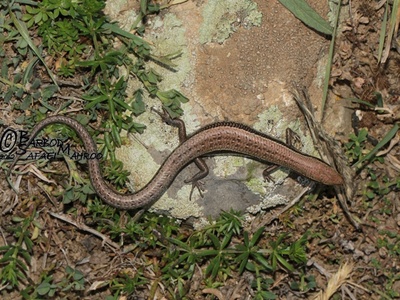
Striped Skink
A common and bold skink often seen on walls, logs, and tree trunks. It is easily recognized by the two pale stripes running down its back. It has adapted well to human presence and is a familiar sight in many gardens.
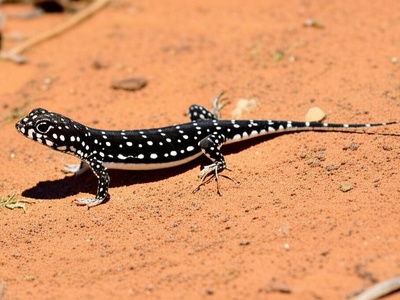
Jalla’s Sand Lizard
A small, terrestrial lizard known for its remarkable juvenile stage, where it mimics the toxic ‘oogpister’ beetle. Young lizards are black with white spots and walk with a stiff-legged gait, fooling predators. Adults are sandy brown.
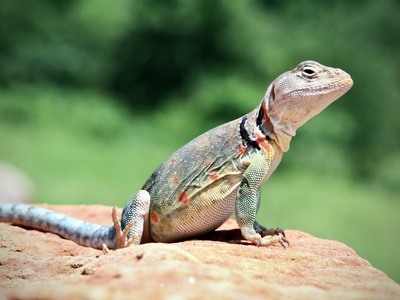
Common Sand Lizard
A fast-moving, slender lizard with a very long tail. It has a complex pattern of stripes and spots that provides excellent camouflage on the sandy ground. It is an active daytime forager, hunting for termites and other insects.
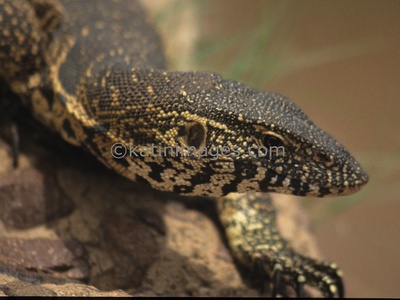
Ornate Sandveld Lizard
A beautiful lizard with rows of pale spots on a dark background. It is typically found in open grassy areas with sandy soil, where it hunts actively for insects during the day. It is very wary and will dart into its burrow at the first sign of danger.
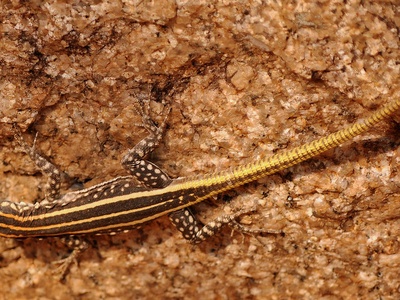
Holub’s Sandveld Lizard
Another member of the active, long-tailed sandveld lizards. This species prefers woodland habitats and forages in leaf litter for termites, its primary food source. It is diurnal and terrestrial.
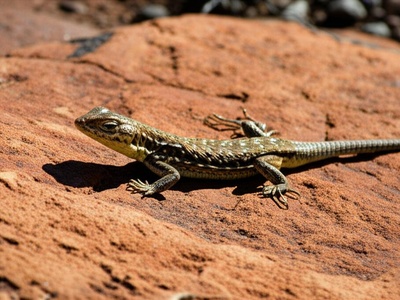
Southern Rock-dwelling Sand Lizard
A small, agile lizard found in hot, dry, rocky areas. It is extremely fast and difficult to approach. It hunts small insects among the rocks and seeks refuge in narrow crevices when threatened.
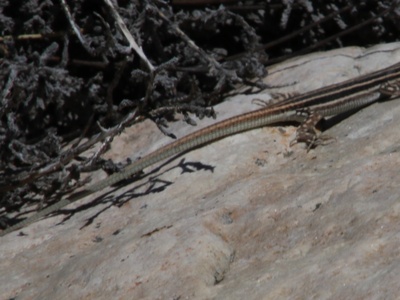
Burchell’s Sand Lizard
A very small lizard adapted to life in arid, sandy environments. It is incredibly swift and forages during the hottest parts of the day. Its pale, sandy colour provides excellent camouflage against the Kalahari sands.
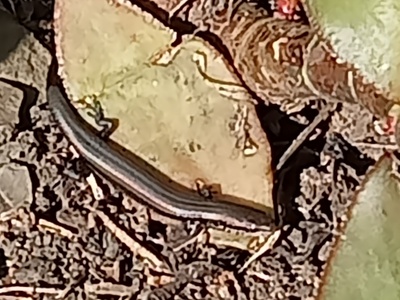
Wahlberg’s Snake-eyed Skink
A small, secretive, ground-dwelling skink that forages in leaf litter. It has a transparent ‘window’ or ‘spectacle’ in its lower eyelid, allowing it to see even when its eyes are closed, hence the name.
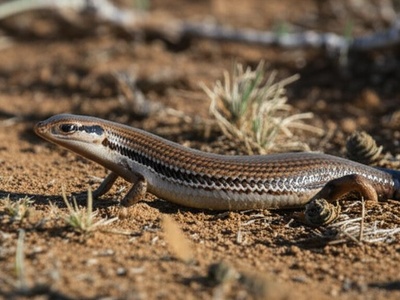
Cunene Snake-eyed Skink
A lesser-known species of snake-eyed skink found in the arid regions of the northwest. Like its relatives, it is a secretive burrower in loose soil and is rarely encountered on the surface.
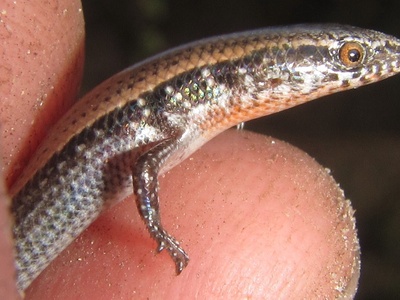
Spotted-neck Snake-eyed Lizard
This lizard is identified by the series of pale, dark-edged spots along its back and a distinctive black-spotted throat pattern. It is a fast-moving, terrestrial lizard that thrives in dry, open habitats.
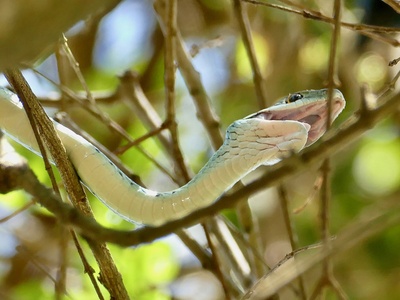
Spotted Bush Snake
A slender, graceful, and harmless snake that is an excellent climber. It is bright green with black spots on the front half of its body. Often found in trees, shrubs, and even on houses, hunting geckos and frogs.
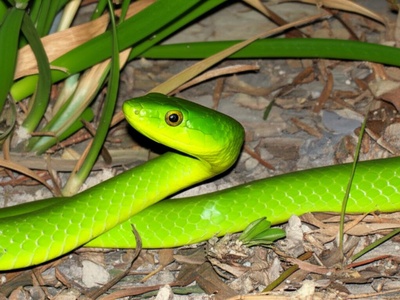
Green Water Snake
A small, uniformly bright green snake that is typically found on the ground or in low vegetation near water. It is harmless and feeds primarily on frogs. It is a capable swimmer.
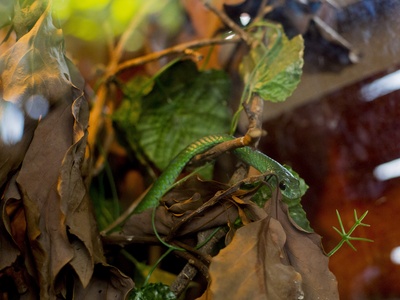
Angolan Green Snake
A larger, more robust green snake than its relatives. It is uniformly emerald green above and yellowish-white below. An agile climber, it spends much of its time in trees and dense bush, preying on frogs and lizards.
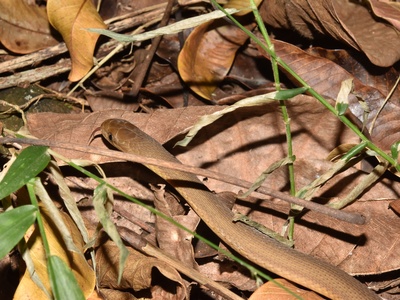
Southern Brown Egg-eater
A non-venomous, specialist snake that feeds exclusively on birds’ eggs. It has a dull brown or olive-grey colour. Its jaws are highly flexible, and its neck vertebrae have projections to crack the egg once swallowed.
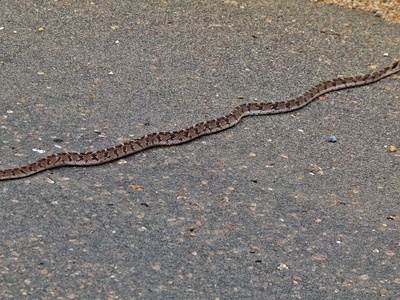
Common Egg-eater
This remarkable non-venomous snake has a V-shaped marking on its head and a rhombic pattern. It mimics venomous adders for defense. It can swallow eggs several times the diameter of its head, then regurgitates the crushed shell.
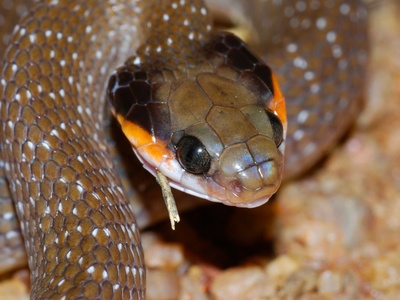
Herald Snake
A common, mildly venomous snake named for the Eastern Cape Herald newspaper, which announced its discovery. It has dark olive or grey colouring and bright red or orange upper lips. It flattens its head and strikes readily when threatened.
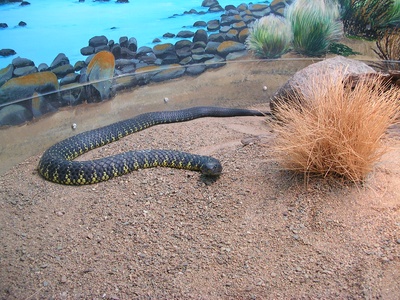
Tiger Snake
A beautifully marked, mildly venomous snake with orange or salmon-pink colouring and black bands. It is nocturnal and preys mainly on lizards and bats, which it hunts in rock crevices and caves. Its venom is not dangerous to humans.
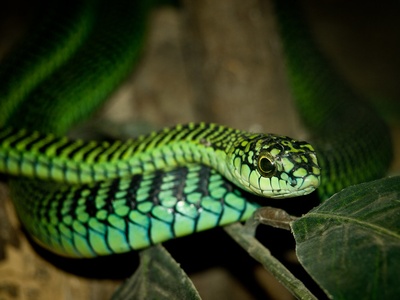
Boomslang
A large, dangerously venomous snake with large eyes and a gentle appearance that belies its potent, haemotoxic venom. Males are often green, while females are brown. It is a shy, tree-dwelling snake that rarely bites unless provoked.
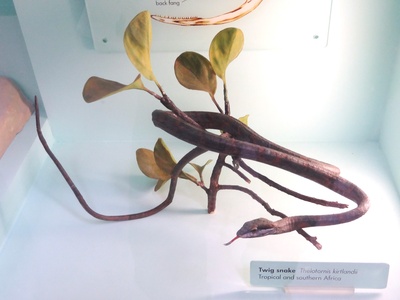
Twig Snake
A master of camouflage, this dangerously venomous snake perfectly mimics a dead twig. It has a long, slender body, a lance-shaped head, and a keyhole-shaped pupil. Its haemotoxic venom is slow-acting but lethal.
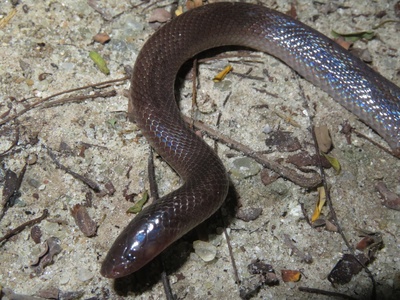
Mole Snake
A large, powerful, non-venomous constrictor. Adults are typically uniform brown or black, while juveniles have a distinct zigzag pattern. It spends much of its time underground hunting moles and rodents in their burrows.
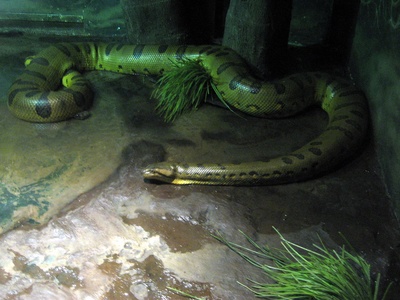
Olive Snake
A semi-aquatic, non-venomous snake that is uniform olive-brown or black. It is often mistaken for a Mole Snake but is more slender and prefers wet habitats. It preys on frogs, tadpoles, and fish.
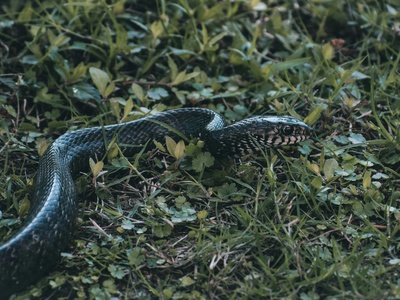
Common Wolf Snake
A small, secretive, nocturnal snake that is completely harmless. It is typically dark brown or black, often with small white speckles. It preys almost exclusively on skinks and other small lizards.
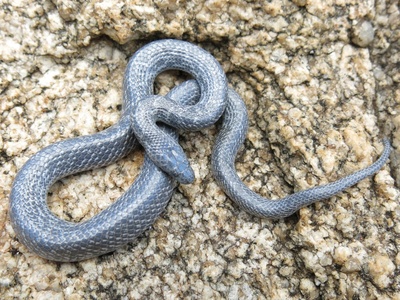
Variegated Wolf Snake
Similar in habit to the Common Wolf Snake, this species is distinguished by its more variegated or blotched pattern. It is a harmless, nocturnal hunter of small, sleeping lizards.
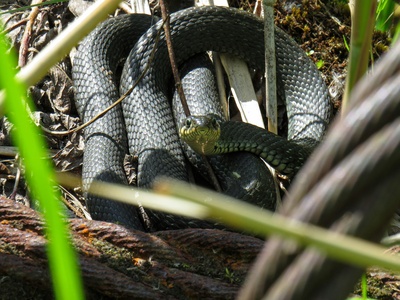
Common File Snake
A unique, non-venomous snake with rough, keeled scales that feel like a three-sided file. It has a triangular body shape and a prominent backbone. It is a nocturnal hunter that specializes in preying on other snakes.
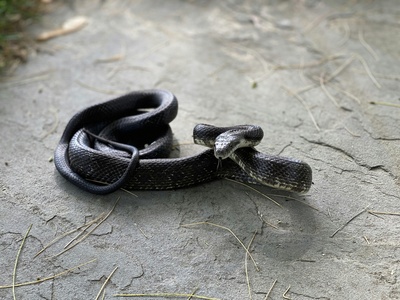
Black File Snake
Smaller than its common relative, this file snake is uniformly black and also preys on other snakes and lizards. Its triangular body and heavily keeled scales are distinctive. It is non-venomous and nocturnal.
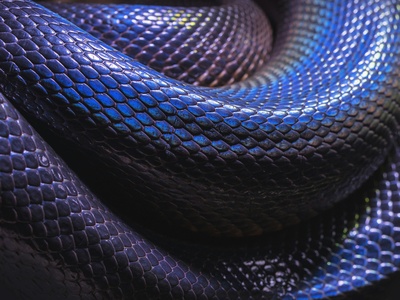
Purple-glossed Snake
A small, secretive, burrowing snake with smooth, iridescent scales that give it a purple sheen. It is mildly venomous but rarely encountered due to its fossorial nature. It preys on other burrowing reptiles.
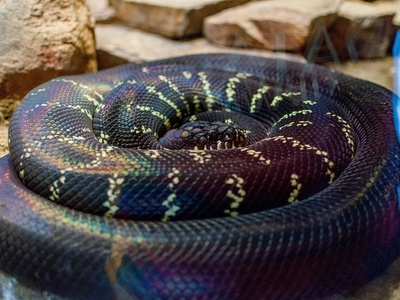
Kalahari Purple-glossed Snake
A burrowing snake adapted to the sandy soils of the Kalahari. It is smaller than its eastern counterpart and has a series of yellow blotches along its belly. It is also mildly venomous and preys on burrowing lizards.
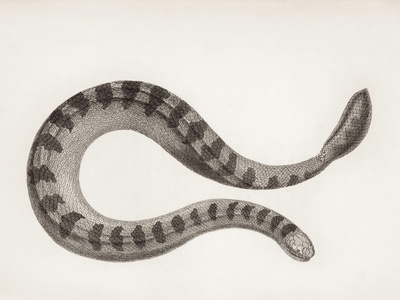
Bibron’s Stiletto Snake
A highly dangerous venomous snake with fangs that can be protruded out of the sides of its mouth, allowing it to bite even without opening its jaws. It is a burrower, often emerging at night after rain. Do not handle.
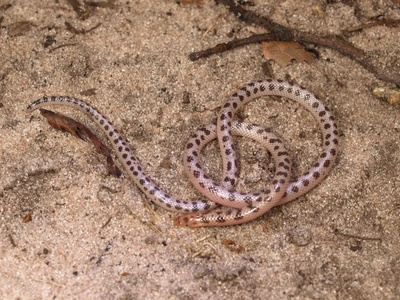
Quill-snouted Snake
A rare, highly specialized burrowing snake with a pointed, shovel-like snout used for digging in loose sand. It is pinkish or yellowish-white with dark blotches. It feeds on amphisbaenians (worm lizards).
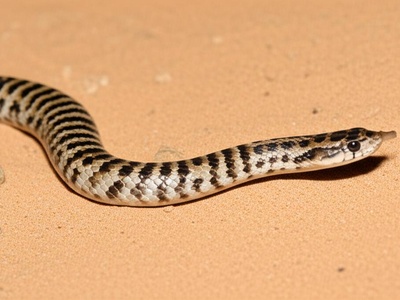
Elongate Shovel-snout
A small, harmless burrowing snake with a distinctive, hardened snout used for digging. It has a blotched pattern and is a specialist feeder on reptile eggs.
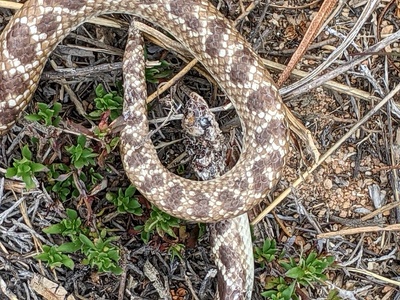
Sundevall’s Shovel-snout
The most common shovel-snout in the region. This small, non-venomous snake is a burrower and feeds on the eggs of lizards and other snakes, which it digs up with its specialized snout.
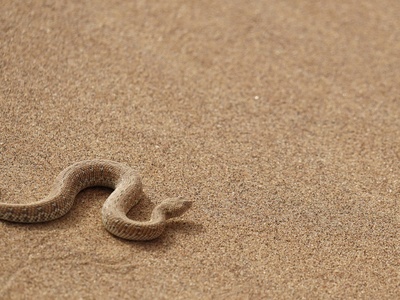
Dwarf Sand Snake
One of the world’s smallest sand snakes. It has a distinctive pattern with a broad, dark vertebral stripe bordered by lighter stripes. It is fast-moving, diurnal, and mildly venomous, preying on small lizards.
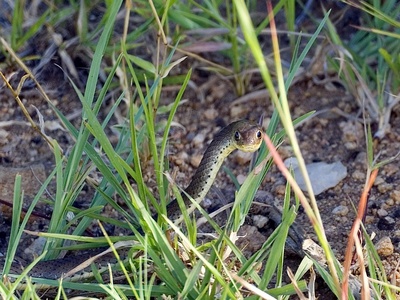
Short-snouted Grass Snake
A fast, slender, diurnal snake often seen hunting lizards in grassy areas. It is mildly venomous, but its venom is not harmful to humans. It has a variable brownish colour with faint stripes.
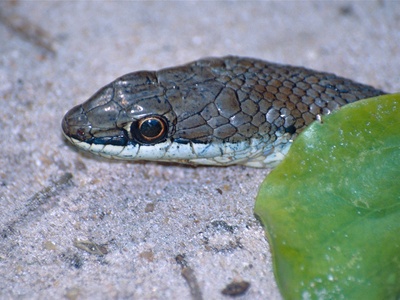
Stripe-bellied Sand Snake
A very fast, slender snake recognized by the two distinct black lines running along its yellowish belly. It is an active daytime hunter, preying on lizards and rodents. It is mildly venomous but poses no threat to people.
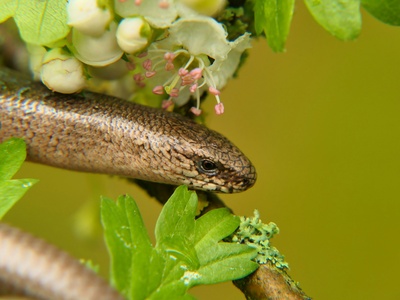
Olive Grass Snake
A large, robust sand snake that is uniform olive-brown. It is often found near rivers and wetlands, where it hunts frogs, lizards, and small mammals. It is a powerful snake with mild venom.
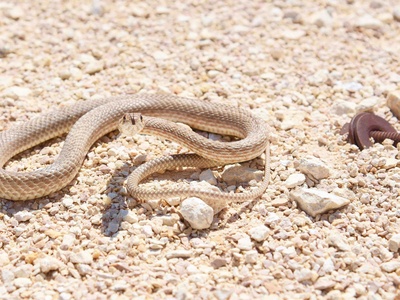
Jalla’s Sand Snake
A sand snake adapted to the arid conditions of the Kalahari. It is pale brown or grey, providing excellent camouflage against the sand. It is a fast diurnal hunter of lizards.
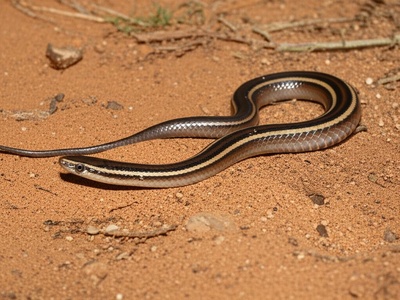
Lined Shovel-snout
A small burrowing snake with a distinct dark line running down its spine. Like other shovel-snouts, it is non-venomous and uses its hardened rostrum to unearth and consume reptile eggs.
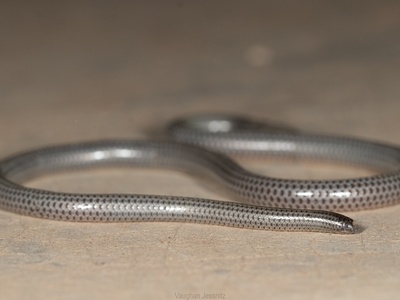
Slender Thread Snake
A tiny, harmless, burrowing snake that resembles a shiny worm. It has vestigial eyes covered by scales and lives underground, feeding on ant and termite larvae. It is one of Zimbabwe’s smallest snake species.
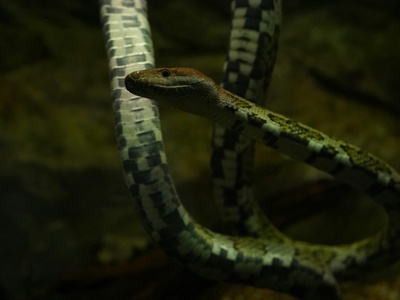
Peters’ Thread Snake
Even smaller than its widespread relative, this blind snake is typically found in moist soil and leaf litter in forested areas. It is completely harmless and feeds on the smallest of insects.
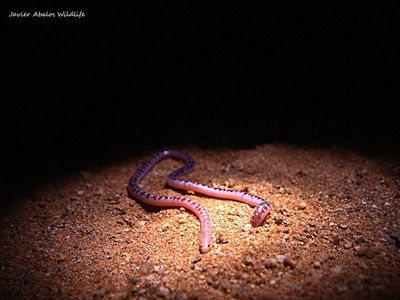
Beaked Blind Snake
A specialized burrowing snake with a large, beak-like scale on its snout for digging. It is pinkish-white and lives almost entirely underground in the loose Kalahari sands, where it hunts for ant pupae.

Zambezi Garter Snake
A secretive, nocturnal, venomous snake. Juveniles are black with white bands, while adults become a more uniform grey or brown. It preys on other snakes, lizards, and frogs. Its venom is neurotoxic.
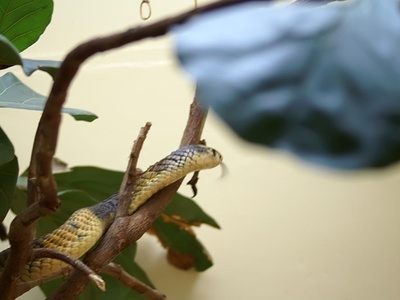
Anchieta’s Cobra
A large, predominantly brown cobra with a preference for drier habitats. It is highly venomous. While it can spread a narrow hood, it is less likely to do so than other cobras. It preys on rodents, toads, and other snakes.
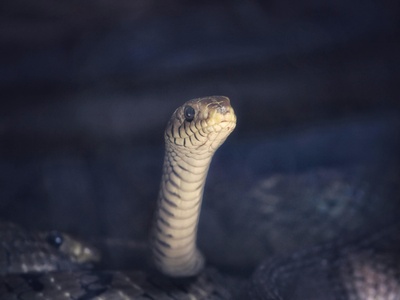
Snouted Cobra
A large, highly venomous cobra, identified by its prominent, upturned snout. It can be yellowish-brown, grey, or banded. When threatened, it rears up and spreads a large hood. It is a common cause of serious snakebites.
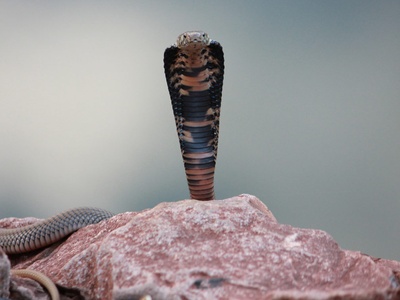
Mozambique Spitting Cobra
A dangerously venomous snake responsible for many bites in Zimbabwe. It can accurately spit cytotoxic venom up to 3 meters, aiming for the eyes. It is also capable of delivering a nasty bite. It is often found near human dwellings.
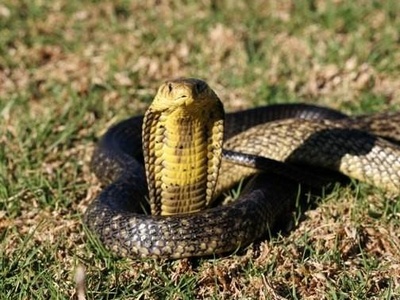
Forest Cobra
Africa’s largest cobra, this is a formidable and highly venomous snake. It is an excellent climber and swimmer, often found in or near water. It is glossy black with a brown head and a yellow-and-black checkered belly.
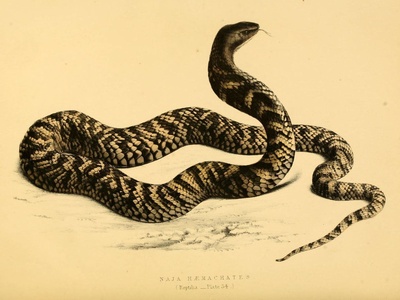
Rinkhals
Not a true cobra, but related. The Rinkhals is famous for shamming death when threatened. It is also a spitter, capable of spraying venom. It has keeled scales and a dark body with irregular yellow or white crossbars on the throat.
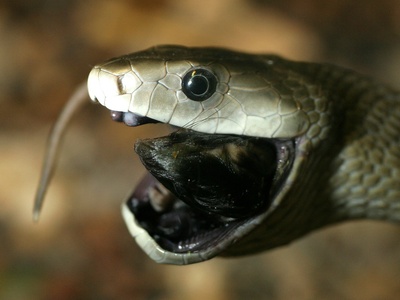
Black Mamba
One of the world’s fastest and most venomous snakes. Not actually black, its name comes from the inky-black interior of its mouth. It has a potent neurotoxic venom and should be avoided at all costs.
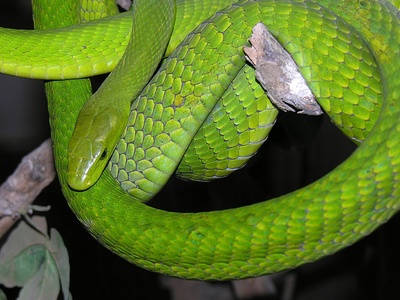
Green Mamba
A slender, arboreal, and highly venomous snake. It is brilliant emerald green, providing perfect camouflage in the forest canopy where it hunts birds and small mammals. It is much shyer and less aggressive than its black relative.
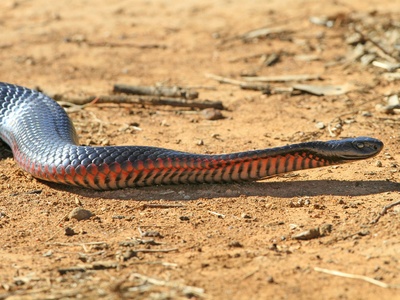
Southern African Python
Zimbabwe’s largest snake. This powerful, non-venomous constrictor kills its prey by suffocation. It can consume large animals like small antelope. Females are dedicated mothers, coiling around their eggs to incubate them.
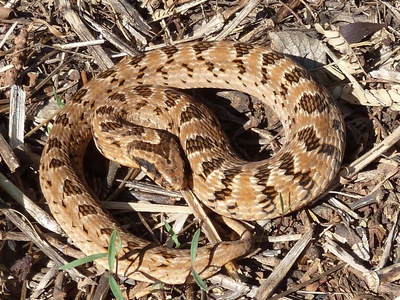
Rhombic Night Adder
A common, venomous snake, active mainly at dusk or night. It is identified by the dark, V-shaped marking on its head and a chain of rhombic blotches down its back. It has a cytotoxic venom that causes painful swelling.
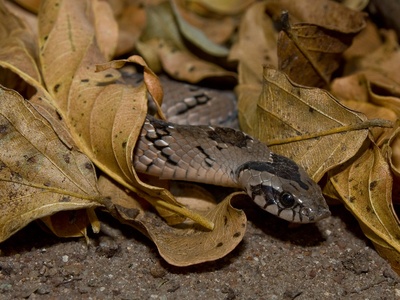
Snouted Night Adder
A very small venomous snake with a distinctly upturned snout. It is nocturnal and preys almost exclusively on frogs and toads. Its venom is not considered dangerous to humans, but the bite can be painful.
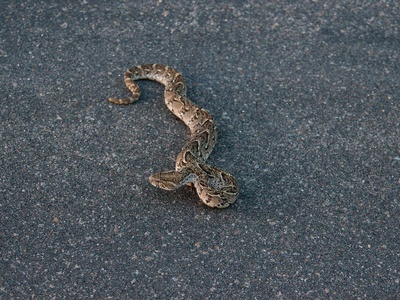
Puff Adder
A fat, slow-moving, and dangerously venomous viper with a cytotoxic venom. It relies on its exceptional camouflage to avoid detection and is responsible for more serious snakebites than any other African snake due to its habit of lying still.
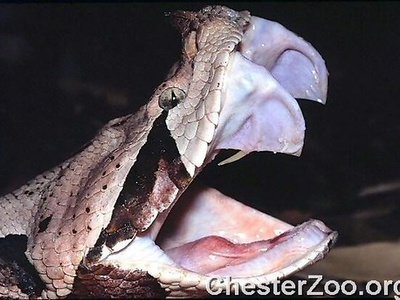
Gaboon Viper
A huge, incredibly thick-bodied viper with the longest fangs of any snake. It has a stunning, geometric pattern that provides perfect camouflage in the leaf litter of the forest floor. Its venom is highly toxic and delivered in large quantities.
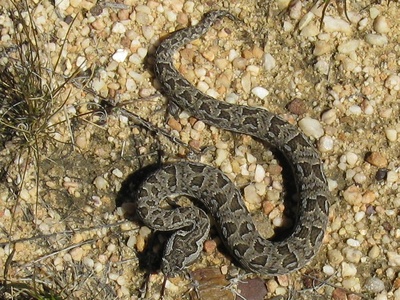
Berg Adder
A small, stout viper found only at high altitudes in the Nyanga and Chimanimani mountains. It has a potent neurotoxic venom, unusual for a viper, that can cause severe symptoms. It is active during the day.
